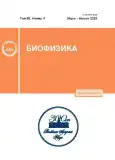Effect of the nitric oxide synthesis inhibitor L-NAME on the isolated rat heart after hypokinesia
- 作者: Sungatullina M.I1, Zaripova R.I1, Ziyatdinova N.I1, Yafarova G.G1,2, Andrianov V.V1,2, Gainutdinov K.L1,2, Zefirov T.L1
-
隶属关系:
- Kazan Federal University
- Zavoisky Physical-Technical Institute - Subdivision of Kazan Scientific Center, Russian Academy of Sciences
- 期: 卷 68, 编号 4 (2023)
- 页面: 754-760
- 栏目: Articles
- URL: https://journals.rcsi.science/0006-3029/article/view/142130
- DOI: https://doi.org/10.31857/S0006302923040166
- EDN: https://elibrary.ru/KMXWGG
- ID: 142130
如何引用文章
全文:
详细
The effects of a non-selective nitric oxide synthase inhibitor L-NAME on the functional parameters of the isolated rat heart after a 30-day period of hypokinesia were studied. Electron paramagnetic resonance spectroscopy was employed in the analysis of a role for L-NAME in the intensity of nitric oxide production in rat heart tissues. The intensity of nitric oxide synthesis was assessed by the intensity of the signal belonging to the (DETC)2-Fe2+-NO complex. It was found that L-NAME decreased nitric oxide production on average by 69%. The Langendorff isolated perfused heart was used to evaluate cardiac activity, and the following parameters were measured: pressure generated by the left ventricle, heart rate, and coronary flow. Addition of the nitric oxide synthesis inhibitor L-NAME induced an increase in inotropic function and normalization of heart rate.
作者简介
M. Sungatullina
Kazan Federal University
Email: ratno1992@mail.ru
Kazan, Russia
R. Zaripova
Kazan Federal University
Email: ratno1992@mail.ru
Kazan, Russia
N. Ziyatdinova
Kazan Federal University
Email: ratno1992@mail.ru
Kazan, Russia
G. Yafarova
Kazan Federal University;Zavoisky Physical-Technical Institute - Subdivision of Kazan Scientific Center, Russian Academy of Sciences
Email: ratno1992@mail.ru
Kazan, Russia
V. Andrianov
Kazan Federal University;Zavoisky Physical-Technical Institute - Subdivision of Kazan Scientific Center, Russian Academy of Sciences
Email: ratno1992@mail.ru
Kazan, Russia
Kh. Gainutdinov
Kazan Federal University;Zavoisky Physical-Technical Institute - Subdivision of Kazan Scientific Center, Russian Academy of Sciences
Email: ratno1992@mail.ru
Kazan, Russia
T. Zefirov
Kazan Federal University
编辑信件的主要联系方式.
Email: ratno1992@mail.ru
Kazan, Russia
参考
- А. Г. Кочетков и Т. И. Васягина, Морфология, 119 (3), 62 (2001).
- Н. Г. Мальцева и Т. Г. Кузнецова, Проблемы здоровья и экологии, 2 (16), 113 (2008).
- Т. Н. Руденко: Дис.. канд. биол. наук (Санкт-Петербург, 2004).
- А. Я. Тизул, Болезни человека, обусловленные дефицитом двигательной активности, и здоровье (Сов. спорт, М., 2001).
- А. И. Усов, Т. И. Васягина и И. Г. Стельникова, Морфология, 127 (2), 47 (2005).
- О. А. Хлущевская и Г. З. Химич, Актуальные проблемы гуманитарных и естественных наук, 6, 110 (2014).
- М. Е. Евсеева, Бюл. эксперем. биол. медицины, 130 (10), 378 (2000).
- N. T. L. Duijnhoven, M. W. P. Bleeker, P. C. E. Groot, et al., Eur. J. Appl. Physiol., 104 (6), 991 (2008).
- А. Ф. Ванин, О. И. Писаренко, И. М. Студнева и др., Кардиология, 12, 43 (2009).
- A. F. Vanin, Nitric Oxide, 54, 15 (2016).
- Е. В. Пожилова и В. Е. Новиков, Вестн. Смоленской гос. мед. академии, 14 (4), 29 (2015).
- Е. В. Пожилова, В. Е. Новиков и О. С. Левченкова, Вестн Смоленской гос. мед. академии 14 (4), 13 (2015).
- В. В. Андрианов, Ф. Г. Ситдиков, Х. Л. Гайнутдинов и др., Онтогенез, 39 (6), 437 (2008).
- Л. Л. Гудков, К. Б. Шумаев, Е. И. Каленикова и др., Биофизика, 52 (3), 503 (2007).
- Г. Ф. Ситдикова и А. Л. Зефиров, Рос. физиол. журн., 92, 872 (2006).
- B. Casadei and C. E. Sears, Progr. Biophys. Mol. Biol., 82 (1-3), 67 (2003).
- T. A. Heinrich, R. S. da Silva, K. M. Miranda, et al., Br. J. Pharmacol., 169, 1417 (2013).
- V. L. Lakomkin, A. F. Vanin, A. A. Timoshin, et al., Nitric Oxide: Biology and Chemistry, 16 (4), 413 (2007).
- J. R. Steinert, T. Chernova, and I. D. Forsythe, Neuroscientist, 16 (4), 435 (2010).
- R. I. Zaripova, N. I. Ziyatdinova, and T. L. Zefirov, Bull. Exp. Biol. Med., 161 (2), 215 (2016).
- В. Т. Ивашкин и О. М. Драпкина, Клиническое значение оксида азота и белков теплового шока (ГЭО-ТАРМедиа, М., 2011).
- K. Qingdong and M. Costa, Mol. Pharmacol., 70 (5), 1469 (2006).
- K. T. Navin, et al., J. Cardiovasc. Pharmacol., 39 (2), 298 (2002).
- N. D. Roe and J. Ren, Vascul. Pharmacol., 57, 168 (2012).
- Р. Р. Нигматуллина, А. Г. Насырова и Ф. Ф. Рахматуллина, Бюлл. экспер. биол. и мед., 134 (7), 40 (2002).
- А. В. Мальцев и Ю. М. Кокоз, Кардиология, 59 (4), 52 (2019).
- A. V. Maltsev, M. N. Nenov, O. Yu. Pimenov, et al., Biol. Membranes: Journal of Membrane and Cell Biology, 30 (2), 92 (2013).
- О. Ю. Пименов, М. Х. Галимова, Э. В. Евдокимовский и др., Биофизика, 64 (5), 917 (2019).
- Р. И. Зарипова, Х. Л. Гайнутдинов и Т. Л. Зефиров, Бюл. эксперим. биол. мед., 157 (5), 554 (2014).
- Р. И. Зарипова, Г. Г. Яфарова, В. В. Андрианов и др., Журн. техн. физики, 92 (7), 999 (2022).
- V. V. Khramtsov and L. B. Volodarsky. Biol. Magn. Resonance, 14, 109 (1998).
- В. Д. Микоян, Л. Н. Кубрина и А. Ф. Ванин, Биофизика, 39, 915 (1994).
- Kh. L. Gainutdinov, S. A. Gavrilova, V. S. Iyudin, et al, Appl. Magn. Resonance, 40 (3), 267 (2011).
- Х. Л. Гайнутдинов, В. В. Андрианов, В. С. Июдин и др., Биофизика, 58 (2), 276 (2013).
- M. I. Sungatullina, R. I. Zaripova, and Kh. L. Gainutdinov, Archivos Venezolanos de Farmacologia y Terapeutica, 39 (7), 808 (2020).
- Р. И. Зарипова, В. В. Андрианов, Г. Г. Яфарова и др., Рос. физиол. журн., 100 (8), 926 (2014).
- Р. И. Зарипова, Г. Г. Яфарова, В. В. Андрианов и др., Биофизика, 66 (3), 572 (2021).
- А. Н. Павлов, О. В. Семячкина-Глушковская и С. В. Капралов, Фундаментальные исследования, 2, 112 (2010).
- M. I. Sungatullina, R. I. Zaripova, Kh. L. Gainutdinov, et al, J. Exp. Biol. Agricult. Sci., 8 (2), S303 (2020).
补充文件









